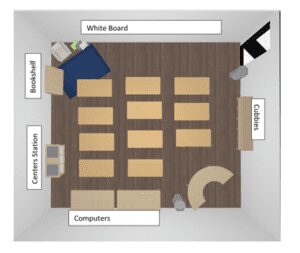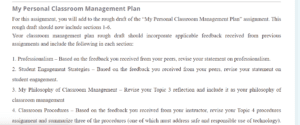Personal Classroom Management Plan
Professionalism
One of my main goals as a future educator is to shape professionalism in my classroom. It is my goal to be professional with students, their families, other educators, and administrators in the organizations within which I will work. I aim to be professional by giving all students a chance regardless of their individual characteristics and backgrounds. I aim to teach all students with the belief that they can learn. I will take the time to understand every student’s individual needs and concerns. I want to create an environment where students with special needs can achieve academic competencies like the rest of the classroom. I will communicate effectively and with a lot of care so that all students are involved. Most importantly, I will create an environment that supports individual and collaborative learning. When students desire to learn, they will find the resources they need to do so. I believe that learning takes place beyond the classroom. That is why my professionalism considers the importance of involving families in student learning. I will engage students’ families in conversation and decision-making so that they can have an impact on the students’ learning at home. In doing so, I want to use communication strategies that encourage parents from diverse backgrounds to be involved in their students’ learning processes.
Student Engagement Strategies
Student engagement relates directly to their motivation and success in the classroom. In my future classroom, I plan on using different student engagement strategies to encourage personal interest in learning and self-motivation to achieve success within and outside the classroom. Engagement also fosters social interaction, which is critical to child learning and development (Axelson & Flick, 2010). The participation in the classroom that is caused by student engagement encourages the students to learn together and develop their social interactions.
There are different strategies that can be used to foster an environment of student engagement. One of these strategies is connecting learning to the real world. When the class content is relatable, the students are excited to share more about their lives and how they relate to what they are learning (Parsons & Taylor, 2011). Additionally, engagement can be encouraged by using teamwork and collaboration strategies in the classroom. Encouraging students to work together in teams enhances their ability to contribute to content in an environment that makes them comfortable (Barkley & Major, 2020). There are also some modern strategies that can be used to encourage engagement, such as video games and video assignments for students. In my future role as an educator, I will use these strategies to encourage student engagement.
Philosophy
My teaching philosophy is centered on the idea of diversity. I believe that no student is exactly the same as another. Children have different personalities, learning abilities, social backgrounds, demographic characteristics, and many other factors that affect their learning. I believe that regardless of the students’ characteristics, they have the ability to learn. The only difference is that some will learn faster than others, and some may need some modifications to learn effectively. I believe that understanding diversity in the classroom is an important part of classroom management. Identifying the needs of each student helps to design strategies for teaching and behavior control that best fit the characteristics of each student (Grand Canyon University). This approach also gives every student the opportunity to learn regardless of their differences.
Classroom Procedures
Establishing classroom procedures is important as it helps to minimize distractions and maximize learning. In my teaching profession, I will establish some classroom procedures that minimize distractions and maximize instructional time. The first is the procedure for starting classes. I will greet the students, ask them to put away any distractions such as mobile phones and other digital devices, and then give them a simple task to set the mood for the rest of the lesson. Before the beginning of a class session, the students are just from doing other things that may be distractive. This procedure promotes the responsible use of distractive technologies by making sure students put them away and focus on the class. The next classroom procedure relates to asking for help. In a class of many students, questions can easily derail the lesson. Students need to have a procedure for asking questions and getting help that gets them what they need without derailing the instructional process. Thus, I will create some signs that students will use to signal the teacher when they need something without stopping the lesson. Lastly, the classroom procedures include a procedure for bathroom use. Students can easily slow the instructional process and waste time when they leave for bathroom breaks in between classes (Burden, 2020). Thus, I have created a procedure for students to leave quietly without distracting the rest of the lesson.
Rules, Consequences, and Reward System
I have created a system of rules, consequences, and reward systems that will be used to manage good behavior in the classroom. The following are the main rules of the classroom, the consequences for breaking the rules, and the classroom reward system that will be used to promote good behavior.
1) Students must be seated on their desks as soon as the bell rings
2) No bullying
3) Follow all classroom procedures
4) All assignments and homework must be completed on time
5) No use of swear language
Consequences:
1) Verbal warnings
2) Call parents
3) Lose classroom credit
4) Send to the principal
5) Suspension
Reward System
I will have a classroom credit system where students will be awarded points for good behavior. Points will be taken out when there is bad behavior. Students will receive gifts attached to their behavior scores.
Rationale:
This rules, consequences, and rewards plan is based on behavioral theory. This theory argues that behaviors can be modeled through rewards and punishments (Korpershoek et al., 2016). The rules and consequences are modeled to encourage good behaviors by rewarding the students and discourage bad ones by using punishments. The class credits are the main rewards that will be used to encourage good behavior. On the other hand, different forms of punishment will be used, such as verbal warning, calling parents, losing class credits, sending students to the principal, and suspension in more serious situations. These approaches will help to ensure that students follow the rules. The students will be expected to model behaviors that help them to get rewards and avoid those that will attract punishments.
Classroom Arrangement and Cooperative Learning

Classroom Design
This classroom is designed for a grade four class of about thirty students. At each table sit three students using group table seating to promote cooperative learning (Everston, & et al., 2017). The classroom has designated spaces for carpet time, gives all students a clear view of the whiteboard for instruction, and includes space for centers, space for computers, and a designated bean table for the teacher to work with small groups. Students will have equal access to tools through desk organizers, which will be placed on each table. Desk organizers will include pencils, erasers, crayons, scissors, and glue. All students will have equal opportunities to work at centers throughout the day, giving each student the opportunity to utilize resources and technology in the classroom. Different centers will be set up on the carpet, center station, computers, and bean table. Each center provides different learning pathways for students of all ability levels. When working in centers, students will learn to move from each center clockwise. Students will follow the flow of traffic when lining up. Students will be asked to line up by rows, walk toward the back of the classroom, and then line up along the cubbies as the arrow shows.
Having a classroom arrangement set up with group tables provides more opportunities for students to work together and learn from one another. By incorporating cooperative learning strategies into the classroom through the arrangement, teachers promote student involvement in learning; this increases student independence while building social skills (Everston, & et al., 2017). As students work together to complete learning goals, they learn how to respect one another and build communication skills. These life skills will benefit students throughout their academic lives and outside of the classroom. When teachers apply cooperative learning structures in the classroom, they can incorporate them into many lessons (Kagan, 1989). Cooperative learning structures are useful for teachers to increase student engagement and motivation, overall helping students to thrive academically.
Classroom arrangement plays a big role in minimizing distractions and maximizing productivity. Once teachers get to know their students, they can arrange them into group seating, which will benefit their learning based on different personalities and learning styles. By utilizing classroom arrangements that promote cooperative learning, teachers give students the opportunity to take on a more active role in their education (McGroary, 2013). Classroom arrangements should also consider students who will not work well together to minimize distractions.
References
Axelson, R. D., & Flick, A. (2010). Defining student engagement. Change: The magazine of higher learning, 43(1), 38-43.
Barkley, E. F., & Major, C. H. (2020). Student engagement techniques: A handbook for college faculty. John Wiley & Sons.
Burden, P. (2020). Classroom management: Creating a successful K-12 learning community. John Wiley & Sons.
Evertson, C. M., Emmer, E. T., & Poole, I. R. (2017). Classroom management for elementary teachers. Hoboken, NJ: Pearson.
Grand Canyon University. Professional Dispositions of Learner, Fairness. Retrieved from: http://www.gcu.edu/College-of-Education/Resources/ Professional-Dispositions-of-Learners.php
Kagan, S. (1989). The structural approach to cooperative learning. Educational Leadership, 47(4), 12. Retrieved from https://lopes.idm.oclc.org/login?url=https://www-proquest-com.lopes.idm.oclc.org/trade-journals/structural-approach-cooperative-learning/docview/224857174/se-2?accountid=7374
Korpershoek, H., Harms, T., de Boer, H., van Kuijk, M., & Doolaard, S. (2016). A meta-analysis of the effects of classroom management strategies and classroom management programs on students’ academic, behavioral, emotional, and motivational outcomes. Review of Educational Research, 86(3), 643-680.
McGroary, M. (2013, May 12). The benefits of cooperative LEARNING arrangements in second language instruction. Retrieved February 04, 2021, from https://www.tandfonline.com/doi/abs/10.1080/08855072.1989.106685
Parsons, J., & Taylor, L. (2011). Improving student engagement. Current issues in education, 14(1).
ORDER A PLAGIARISM-FREE PAPER HERE
We’ll write everything from scratch
Question
My Personal Classroom Management Plan
For this assignment, you will add to the rough draft of the “My Personal Classroom Management Plan” assignment. This rough draft should now include sections 1-6.

Personal Classroom Management Plan
Your classroom management plan rough draft should incorporate applicable feedback received from previous assignments and include the following in each section:
- Professionalism – Based on the feedback you received from your peers, revise your statement on professionalism.
- Student Engagement Strategies – Based on the feedback you received from your peers, revise your statement on student engagement.
- My Philosophy of Classroom Management – Revise your Topic 3 reflection and include it as your philosophy of classroom management
- Classroom Procedures – Based on the feedback you received from your instructor, revise your Topic 4 procedures assignment and summarize three of the procedures (one of which must address safe and responsible use of technology). Include your rationale explaining how procedures minimize distractions and maximize instructional time.
- Rules, Consequences, and Reward System – Based on the feedback you received from your instructor, revise your Topic 4 lists of rules, consequences, and rewards. Include the lists and the rationale that explains how the system will help create a safe and productive learning environment.
- Classroom Arrangement and Cooperative Learning: Include your classroom arrangement and rationale from this topic. You will revise it after you receive instructor and peer feedback.
Include at least 3-5 scholarly resources you used to create your classroom management plan.

